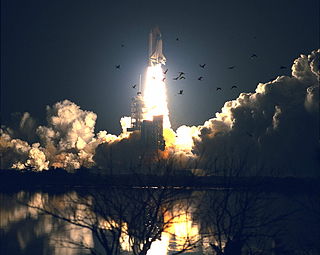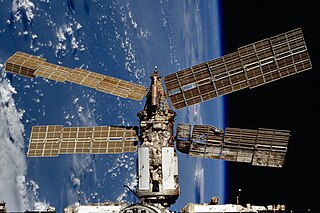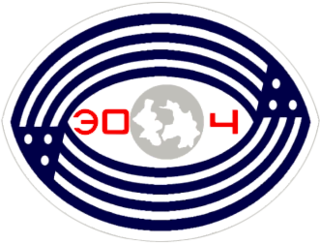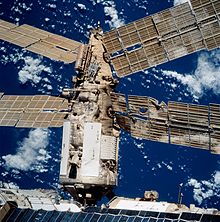
Mir was a space station that operated in low Earth orbit from 1986 to 2001, operated by the Soviet Union and later by Russia. Mir was the first modular space station and was assembled in orbit from 1986 to 1996. It had a greater mass than any previous spacecraft. At the time it was the largest artificial satellite in orbit, succeeded by the International Space Station (ISS) after Mir's orbit decayed. The station served as a microgravity research laboratory in which crews conducted experiments in biology, human biology, physics, astronomy, meteorology, and spacecraft systems with a goal of developing technologies required for permanent occupation of space.

Colin Michael Foale is a British-American astrophysicist and former NASA astronaut. He is a veteran of six space missions, and is the only NASA astronaut to have flown extended missions aboard both Mir and the International Space Station. He was the second Briton in space and the first to perform a space walk. Until 17 April 2008 he held the record for most time spent in space by a US citizen: 374 days, 11 hours, 19 minutes, and he still holds the cumulative-time-in-space record for a UK citizen.

STS-84 was a crewed spaceflight mission by Space Shuttle Atlantis to the Mir space station.

STS-86 was a Space Shuttle Atlantis mission to the Mir space station. This was the last Atlantis mission before it was taken out of service temporarily for maintenance and upgrades, including the glass cockpit.

Anatoly Yakovlevich Solovyev is a retired Russian and Soviet cosmonaut and pilot. Solovyev was born on January 16, 1948, in Riga, Latvia. Solovyev holds the world record on the number of spacewalks performed (16), and accumulated time spent spacewalking.

Soyuz TM-11 was the eleventh expedition to the Russian Space Station Mir, using a Soyuz-TM crew transport vessel. The mission notably carried a Japanese television reporter from Tokyo Broadcasting System.

Soyuz TM-21 was a crewed Soyuz spaceflight to Mir. The mission launched from Baikonur Cosmodrome, atop a Soyuz-U2 carrier rocket, at 06:11:34 UTC on March 14, 1995. The flight marked the first time thirteen humans were flying in space simultaneously, with three aboard the Soyuz, three aboard Mir and seven aboard Space Shuttle Endeavour, flying STS-67.

Soyuz TM-26 was a Russian spaceflight that ferried cosmonauts and supplies to Mir. It was the 32nd expedition to Mir. It was launched by a Soyuz-U rocket from Baikonur Cosmodrome on August 5, 1997. The main mission was to transport two specially-trained cosmonauts to repair or salvage the troubled space station.

Pavel Vladimirovich Vinogradov is a cosmonaut and former commander of the International Space Station. As of May 2013, he has flown into space three times, aboard Mir and the International Space Station, and is one of the top 10 astronauts in terms of total time in space. Vinogradov has also conducted seven spacewalks in his cosmonaut career, and holds the record for the oldest person to perform a spacewalk.

Aleksandr Ivanovich Lazutkin is a Russian cosmonaut.

Expedition 2 was the second long-duration spaceflight aboard the International Space Station, immediately following Expedition 1. Its three-person crew stayed aboard the station from March to August 2001. In addition to station maintenance, the crew assisted in several station assembly missions, welcomed the first space tourist Dennis Tito, and conducted some scientific experiments.

The Shuttle–Mir program was a collaborative 11-mission space program between Russia and the United States that involved American Space Shuttles visiting the Russian space station Mir, Russian cosmonauts flying on the Shuttle, and an American astronaut flying aboard a Soyuz spacecraft to engage in long-duration expeditions aboard Mir.

Spektr was the fifth module of the Mir Space Station. The module was designed for remote observation of Earth's environment containing atmospheric and surface research equipment. Spektr also had four solar arrays which generated about half of the station's electrical power.

Mir EO-24 was the 24th long-duration mission to Russia's Mir space station.
Progress M-17 was a Russian uncrewed cargo spacecraft which was launched in 1993 to resupply the Mir space station. The thirty-fifth of sixty-four Progress spacecraft to visit Mir, it used the Progress-M 11F615A55 configuration, and had the serial number 217. In addition to delivering cargo, Progress M-17 was also used to demonstrate extended duration Progress missions; remaining in orbit for almost a year with a docked phase lasting 132 days.

Mir EO-4 was the fourth long-duration expedition to the Soviet space station Mir. The expedition began in November 1988, when crew members Commander Aleksandr Volkov and Flight Engineer Sergei Krikalev arrived at the station via the spacecraft Soyuz TM-7. The third crew member of EO-4, Valeri Polyakov, was already aboard Mir, having arrived in August 1988 part way through the previous expedition, Mir EO-3.

Mir EO-2 was the second long duration expedition to the Soviet space station Mir, and it lasted from February to December 1987. The mission was divided into two parts, the division occurring when one of the two crew members, Aleksandr Laveykin, was replaced part way through the mission by Aleksandr Aleksandrov. Laveykin was replaced because ground-based doctors had diagnosed him with minor heart problems.

Mir EO-19 was the nineteenth crewed expedition to the space station Mir, lasting from June to September 1995. The crew, consisting of Russian cosmonauts Anatoly Solovyev and Nikolai Budarin, launched on June 27, 1995 aboard the Space Shuttle Atlantis on the STS-71 mission. After remaining aboard Mir for approximately 75 days, Solovyev and Budarin returned aboard the Soyuz TM-21 spacecraft on September 11, 1995.

Progress M-34 was a Russian uncrewed cargo spacecraft which was launched in 1997 to resupply the Mir space station, and which subsequently collided with Mir during a docking attempt, resulting in significant damage to the space station.

Mir EO-8 was the eighth crewed expedition to the space station Mir, lasting from December 1990 to May 1991. The crew, consisting of Russian cosmonauts Viktor Afanasyev and Musa Manarov, launched along with space journalist Toyohiro Akiyama on December 2, 1990 aboard Soyuz TM-11. Akiyama returned aboard Soyuz TM-10 with the outgoing Mir EO-7 crew on December 10. Afanasyev and Manarov returned aboard Soyuz TM-11 on May 26, 1991.



















